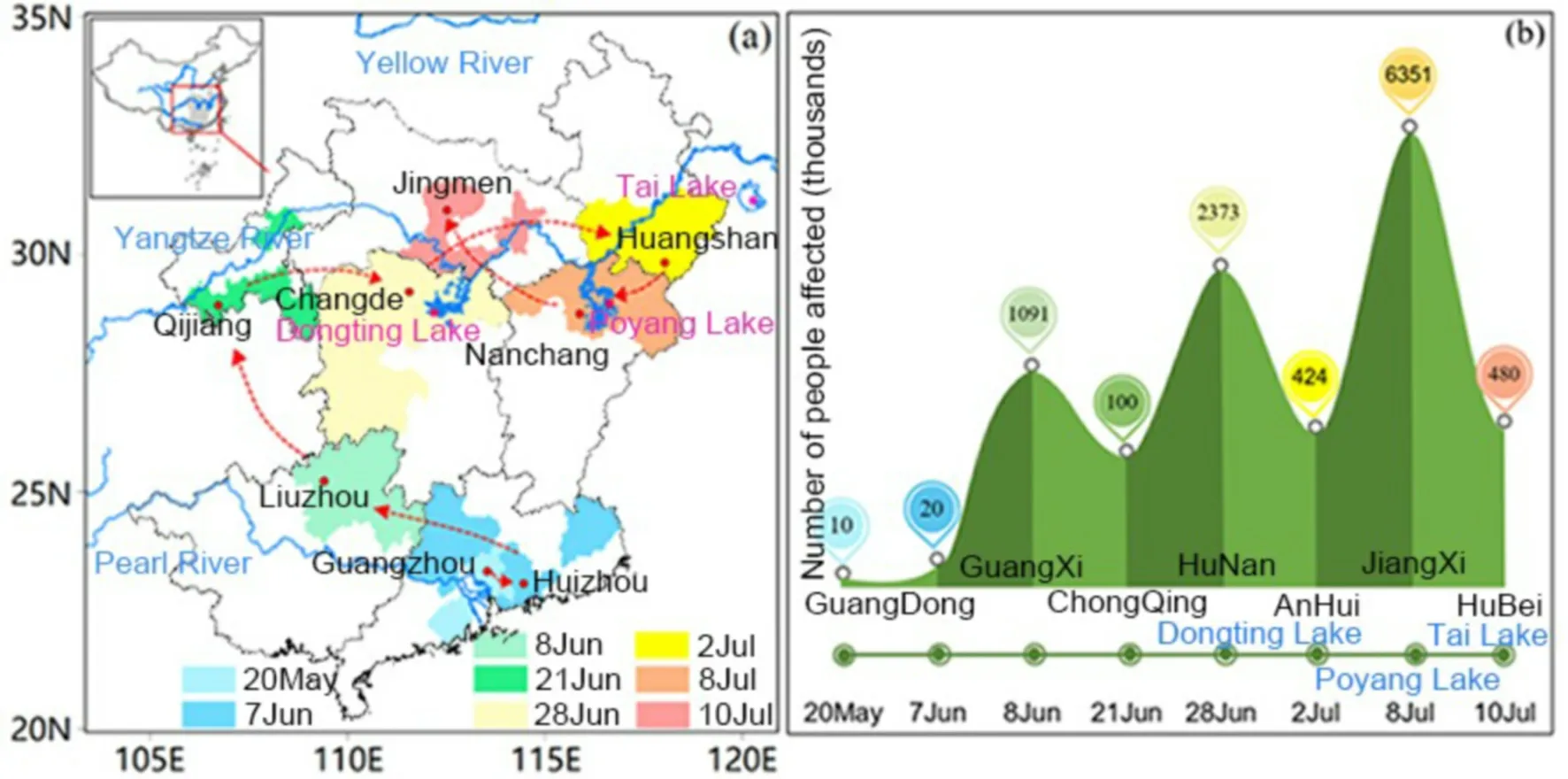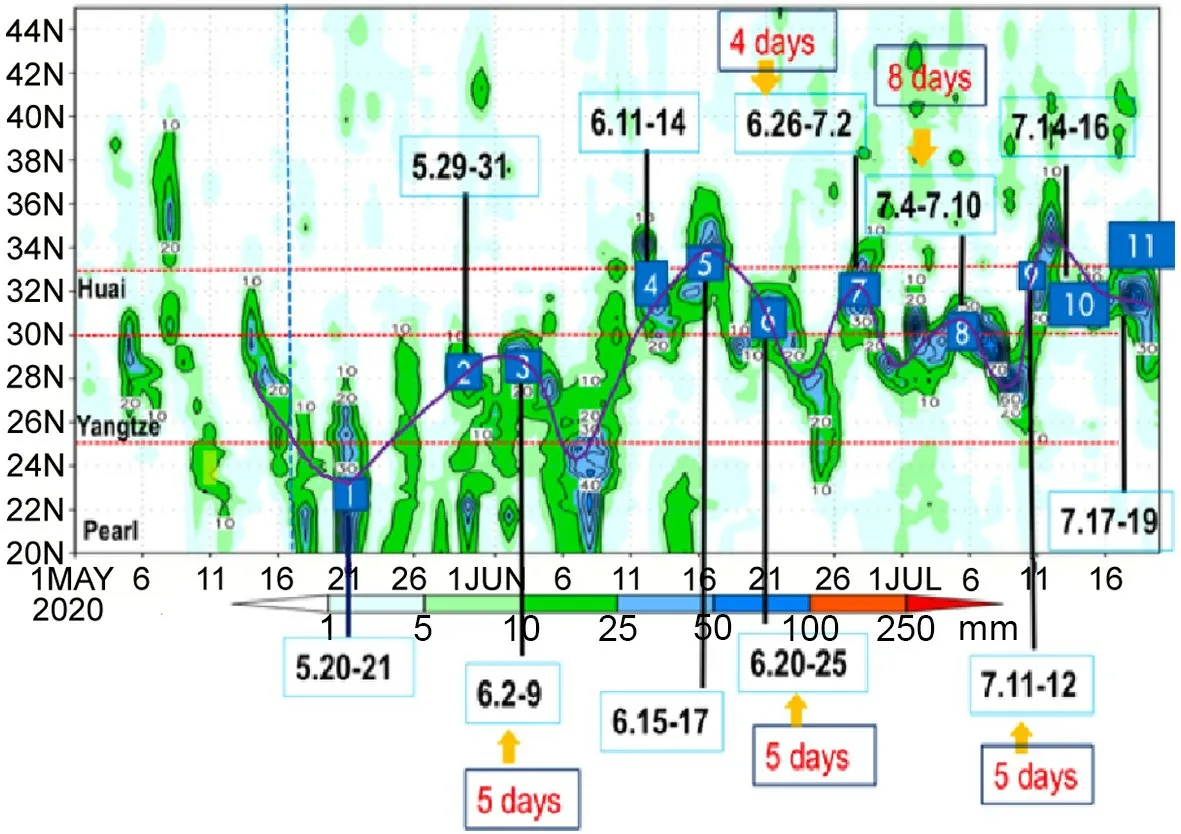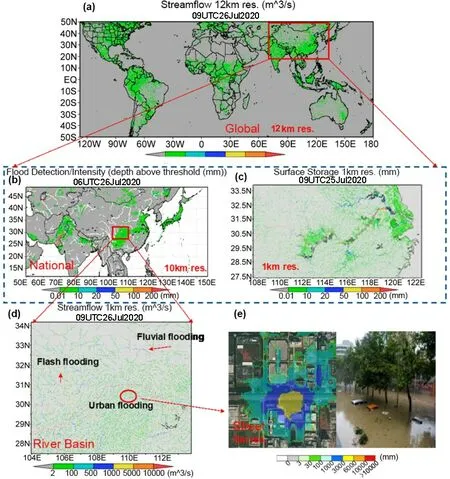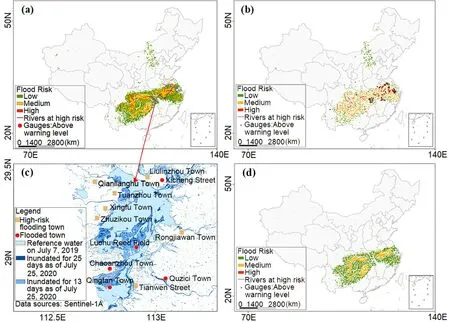From China’s Heavy Precipitation in 2020 to a “Glocal”Hydrometeorological Solution for Flood Risk Prediction
2021-01-05HuanWUXiaomengLIGuySCHUMANNLorenzoALFIERIYunCHENHuiXUZhifangWUHongLUYaminHUQiangZHUZhijunHUANGWeitianCHENandYingHU
Huan WU, Xiaomeng LI, Guy J.-P. SCHUMANN, Lorenzo ALFIERI,Yun CHEN, Hui XU, Zhifang WU, Hong LU, Yamin HU, Qiang ZHU,Zhijun HUANG, Weitian CHEN, and Ying HU
1Guangdong Province Key Laboratory for Climate Change and Natural Disaster Studies, and School of Atmospheric Sciences, Sun Yat-sen University, Guangdong 510000, China
2Southern Marine Science and Engineering Laboratory, Guangdong 519000, China
3Earth System Science Interdisciplinary Center, University of Maryland, Maryland 20742, USA
4School of Geographical Sciences, University of Bristol, Bristol BS8 1TH, UK
5DFO Global Flood Observatory, University of Colorado Boulder, Boulder 80309, USA
6CIMA Research Foundation, Savona 17100, Italy
7National Meteorological Center, Beijing 100081, China
8Guangdong Meteorological Center, Guangzhou, Guangdong 510000, China
9GuangXi Climate Center, Nanning, Guangxi 530000, China
10Guangdong Climate Center, Guangzhou, Guangdong 510000, China
11China Three Gorges Corporation, Beijing 100081, China
ABSTRACT The prolonged mei-yu/baiu system with anomalous precipitation in the year 2020 has swollen many rivers and lakes,caused flash flooding, urban flooding and landslides, and consistently wreaked havoc across large swathes of China,particularly in the Yangtze River basin. Significant precipitation and flooding anomalies have already been seen in magnitude and extension so far this year, which have been exerting much higher pressure on emergency responses in flood control and mitigation than in other years, even though a rainy season with multiple ongoing serious flood events in different provinces is not that uncommon in China. Instead of delving into the causes of the uniqueness of this year’s extreme precipitation-flooding situation, which certainly warrants in-depth exploration, in this article we provide a short view toward a more general hydrometeorological solution to this annual nationwide problem. A “glocal” (global to local)hydrometeorological solution for floods (GHS-F) is considered to be critical for better preparedness, mitigation, and management of different types of significant precipitation-caused flooding, which happen extensively almost every year in many countries such as China, India and the United States. Such a GHS-F model is necessary from both scientific and operational perspectives, with the strength in providing spatially consistent flood definitions and spatially distributed flood risk classification considering the heterogeneity in vulnerability and resilience across the entire domain. Priorities in the development of such a GHS-F are suggested, emphasizing the user’s requirements and needs according to practical experiences with various flood response agencies.
Key words: flooding, flood risk, global to local, hydrological model, extreme precipitation
1. Summary of recent precipitation and flooding in China
Due to an earlier-than-usual onset of the South China Sea summer monsoon and a more northward location retained by the western Pacific subtropical high in 2020, the mei-yu front occurred earlier than in most other years. The prolonged meiyu/baiu system with anomalously high precipitation swelled many rivers and lakes, caused flash flooding, urban flooding and landslides, wreaking havoc across large areas of China, particularly in the Yangtze River basin. From 20 May to 18 July 2020, at least seven major flood events occurred extensively along the timeline shown in Fig. 1a. The events extended across large parts of central-eastern and southern China—specifically, the provinces of Guangdong, Guangxi, Guizhou,Chongqing, Hubei, Jiangxi, Anhui and Jiangsu. Recurring heavy precipitation systems repeatedly (twice or more times)occurred over many locations (Fig. 2). A total of seven heavy rainfall events (Fig. 2) occurred in the middle and lower Yangtze River basin between 1 June and 12 July, with average precipitation of 403 mm for the entire river basin, 49%higher than the average amounts for the same period over the past 60 years. As a result, Jiangxi Province and several other cities along the Yangtze River raised their emergency response level for flood control from the second to the top response level on China’s four-tier scale, which is typically used to account for the possibility of severe disasters such as dam collapses or extraordinary floods occurring simultaneously in several neighboring rivers. Tai Lake was also under emergency status for more than 20 days. As of 12 July, severe flooding had affected almost 40 million people in 27 provinces (Fig. 1b):141 people dead or missing, 2.24 million people evacuated to other places, 28 000 homes destroyed and 3532 acres of agricultural land inundated, according to media reports.

Fig. 1. (a) Distribution map of flood events from late May to mid-July 2020. Red arrows indicate the timeline of flood-event occurrences and red dots indicate the most severely affected cities. (b) Number of people affected by each major event, according to social media sources.

Fig. 2. Daily zonal mean precipitation over part of mainland China(20°—44.5°N). Eleven extreme precipitation events (dates in bold black font)in central to eastern China since the onset of the monsoon up to 28 July 2020.The number of days (in red) are the lead days when corresponding events were skillfully predicted with good quality using medium- and extendedrange quantitative precipitation forecasting by the National Meteorological Center.
These anomalously high precipitation and severe flooding events have resulted in serious impacts, exerting much higher than usual pressure on emergency response, flood control and mitigation measures, yet simultaneously occurring severe flood events in different locations due to heavy long-lasting rainfall is not uncommon for China. Timely and accurate maps showing current and days-ahead flood risk at both regional and local scales are thus highly desirable for decisionmakers. This is clearly within the scope of responsibility and within the capabilities of the international hydrometeorological community. Instead of looking into the causes of this year’s extreme flooding, which certainly warrants in-depth analysis, in this article we intend to provide a short view toward a more general hydrometeorological solution to this problem of growing concern at the global level. We urge the international hydrometeorological community to do more for better preparedness and for a better response to such catastrophic flooding events, in particular from the perspective of hydrometeorological modeling, given the projections of more frequent and extreme precipitation events under a continuously warming climate (e.g., Allan and Soden, 2008; Trenberth, 2011; Chen et al., 2020). Given the complex relationship between precipitation and flooding (Wu et al., 2017; Yan et al., 2020), detailed and accurate monitoring and better forecasting of flooding ought to be done jointly between the meteorological and the hydrological communities, through sharing observations, measurements and modeled data, modeling techniques and outputs, as well as expertise and lessons learned.
2. Flood risk monitoring and forecasting at global to local scales
An encompassing view of flood occurrences, evolution, extent dynamics, and spatial distribution of areas at high risk from flooding over a global or national scale with local detail, is highly desirable and yet missing for international and national agencies with a mandate in flood response and management. The decision-makers of organizations, such as the United Nations World Food Programme, the Chinese Ministry of Emergency Management, the Federal Emergency Management Agency in the United States, need to pre-allocate and prioritize their mitigation resources among multiple simultaneous severe events (including many different types of disasters). They also have to optimize the synergies within and among organizations for disaster mitigation across the affected areas, largely relying on information available from the hydrometeorological community. Recurring heavy precipitation over flooded areas or basins often exacerbates the critical situation. As seen in Fig. 2, four significant rain events circled between the Pearl River basin and Yangtze River basin in May and June; and there were seven extreme precipitation events moving between the Yangtze River basin and Huaihe River basin since mid-June, leading to major flooding across many parts of the Yangtze River basin. Between 19 July and 27 July, downtown Enshi City of Hubei Province suffered severe flooding twice, like several other cities that experienced repeated severe flooding over a relatively short period of time. A flood modeling system that can delineate and predict such large-scale rainfall-and-flood event dynamics is much needed by decision-makers for providing situational awareness of the areas affected or at risk. Large-scale hydrodynamic models, coupled with numerical weather prediction modeling and complemented by the latest developments in remote sensing, have been shown to be extremely valuable in the monitoring and forecasting of floods, as well as in the context of transboundary river basins, spanning several countries, provinces or different administrative regions (Wu et al., 2012, 2014; Alfieri et al., 2013). These large-scale models have shown reasonable capabilities in translating precipitation events into flood maps across multiple spatial and temporal scales with sufficiently essential details, and at different lead times.
Meanwhile, practical flood defense and mitigation efforts are conducted at local level and in upstream headwater areas prone to flash flooding and are put in place quickly, following heavy rainfall, and in certain river reaches and reservoirs/lakes after upstream flood waves cause significant fluvial flooding in downstream areas. However, although fluvial floods usually develop from upstream (flash) flooding, different methods and tools exist to predict and warn against fluvial flooding and pluvial (flash) flooding. Fluvial flooding is predicted mostly using process-based hydrological or hydraulic models with different levels of representation of river channel geometry, floodplain topography and flood defense measures. Pluvial and flash flooding is typically forecast based on data-driven techniques, and on the identification of extreme rainfall intensities over short periods, although hydrological models are often involved to improve the simulation of the flood dynamics. In addition to differences in defense mechanisms between fluvial floods and flash floods, and different challenges in deriving reliable predictions for both, hydrologists and meteorologists are typically not collaborating given the non-trivial differences in and traditional separation of the disciplines they work in. However, in reality, there is of course no clear boundary between pluvial (flash) floods and fluvial flooding (Figs. 3a—c). A state-of-the-art flood modeling framework should be able to provide both large-scale flood detection and detailed flood delineation at local scales with sufficient levels of accuracy.

Fig. 3. Schematic illustration of a GHS-F: DRIVE model, including an urban flood module in addition to pluvial(flash) flooding and fluvial flood modeling.
3. “Glocal” hydrometeorological solution to floods
A “glocal” (global to local) hydrometeorological solution to floods (GHS-F) is considered to be critical for better preparedness, mitigation, and management of different types of significant precipitation-caused flooding, which happens extensively almost every year in many countries around the world, including China, India and the United States. Such a GHS-F model is necessary from both scientific and operational perspectives in order to provide spatially consistent and actionable flood information as well as spatially distributed flood risk classification accounting for the heterogeneity in vulnerability and resilience across the entire model domain. It would track the movement of precipitation and flooding while allowing scalable (multiple spatial resolution) flood information to meet various users’ requirements and needs. Hydrological models consider the water movement from hill-slope runoff generation and routing in connected river networks that link hillslopes where flash floods may originate to downstream floodplain areas. Within the GHS-F, accurate pluvial flood simulations can provide direct input to fluvial flood simulations in downstream higher-order rivers. More importantly, to address the concerns of decision-makers with regards to model-based flood predictions, a GHS-F can facilitate evaluation of uncertainties in flood forecasting. Hydrological simulation coupled with weather forecasting, e.g., WRF-hydro (Gochis et al., 2013), is an increasingly appealing option for a GHS-F to achieve better atmosphere—land interactions for enhanced local convection modeling and flash flood forecasting.
The feasibility of a high-resolution large-scale flood model had been suggested about 10 years ago by Wood et al.(2011), with a lot of ensuing and interesting discussion (Beven and Cloke, 2012; Bierkens et al., 2015). We have now reached the era of unprecedented computing capability and timely data availability as well as model and data interoperability, so as to unify a modeling platform for monitoring and forecasting flood risk from global to local scales, and from flash flood to fluvial flood, including urban flooding (Fig. 3). Urban flooding is usually caused by high water levels in river channels and/or extreme precipitation in urban areas, which saturate the capacity of the drainage system. The Global Flood Monitoring System (GFMS) based on the Dominant river tracing-Routing Integrated with VIC Environment (DRIVE) model developed by Wu et al. (2011, 2012, 2014, 2019) provides a solid blueprint and basis for a GHS-F prototype model (Fig. 4),having been employed routinely to provide global to local flood monitoring and forecasting, serving international, national and local communities with various options for user-specific decision-making, including current ongoing support for response actions of the Chinese Ministry of Emergency Management, on a daily basis.

Fig. 4. An example of GFMS output from global to local scale flooding. (a) Global streamflow distribution map with resolution of 12 km. (b) China’s flood detection/intensity distribution map with resolution of 10 km. (c) Distribution map of surface storage of local watershed with resolution of 1 km (d) Local streamflow distribution map resolution of 1 km. (e) Urban waterlogging map with 5 km resolution.

Fig. 5. (a) Flood detection and intensity by GFMS with the China Meteorological Administration’s real-time quantitative precipitation estimation. (b) Risk estimation of flash flooding. (c) Sentinel-1-based flood inundation mapping for Dongting Lake, with the inset showing the temporal variations of lake areas, estimated by NOAA NPP satellite optical band data,together with the water level measured on the ground at the lake outlet. (d) Fluvial flooding in small- to mid-sized rivers.
The estimation of risk from dam and levee breaches, as well as loss and damage estimations is central to the whole decision-making processes (Fig. 5a). Although decision-makers place high value on observations from ground stations and satellites, significant spatiotemporal gaps exist widely in current observational infrastructures, leading to limited confidence in risk estimation that typically further decreases as the lead time of prediction increases. However, decision-makers tend to value model-based information when observations are not available or the model results show good consistency with observations (Fig. 5b) or reported loss and damage, and can be trusted. Therefore, two critical components of higher priority are suggested in developing a GHS-F. First, the real-time assimilation of streamflow or water level observations,which is particularly important for improving the modeling of larger rivers that are often significantly regulated by dam and reservoir operations, and significantly affected by various human activities, leading to modified flood peak magnitude and timing. The second important component that should be implemented in a GHS-F as a top priority is a high-resolution hydrodynamic module for better simulation of floodplain inundation, flood duration and water storage, with the capability of integrating with or assimilating high-resolution inundation mapping from remote sensing (Fig. 5c). With these two major components, inundation depth and duration can be accurately modeled at high spatial resolutions (e.g., 5—10 m) in both nowcasting and forecasting modes, providing the critical basis for damage function derivation and risk assessment.
With this said, high-quality precipitation forecasting always plays the most important role in driving models from global to local scales, which is the main link connecting the meteorological and hydrological communities for a joint undertaking in better predicting and mapping severe flooding, such as that still ongoing in China and several other places around the world. High-quality precipitation forecasting with an adequate lead time of four to eight days, for example, looks promising for a GHS-F to produce better flood outputs and flood risk monitoring and forecasting capabilities.
This study was supported by the National Key R&D Program of China (Grant No. 2017YFA0604300) and the National Natural Science Foundation of China (Grant Nos. 41861144014, 41775106 and U1811464), as well as partially by the Program for Guangdong Introducing Innovative and Entrepreneurial Teams (Grant No. 2017ZT07X355) and the project of the Chinese Ministry of Emergency Management on “Catastrophe Evaluation Modeling Study”.杂志排行
Advances in Atmospheric Sciences的其它文章
- A New TanSat XCO2 Global Product towards Climate Studies
- Influence of the Eastern Pacific and Central Pacific Types of ENSO on the South Asian Summer Monsoon
- Evaluation of Arctic Sea-ice Cover and Thickness Simulated by MITgcm
- Variations in Wave Energy and Amplitudes along the Energy Dispersion Paths of Nonstationary Barotropic Rossby Waves
- Precipitation Microphysical Processes in the Inner Rainband of Tropical Cyclone Kajiki (2019) over the South China Sea Revealed by Polarimetric Radar
- High-resolution Simulation of an Extreme Heavy Rainfall Event in Shanghai Using the Weather Research and Forecasting Model: Sensitivity to Planetary Boundary Layer Parameterization
